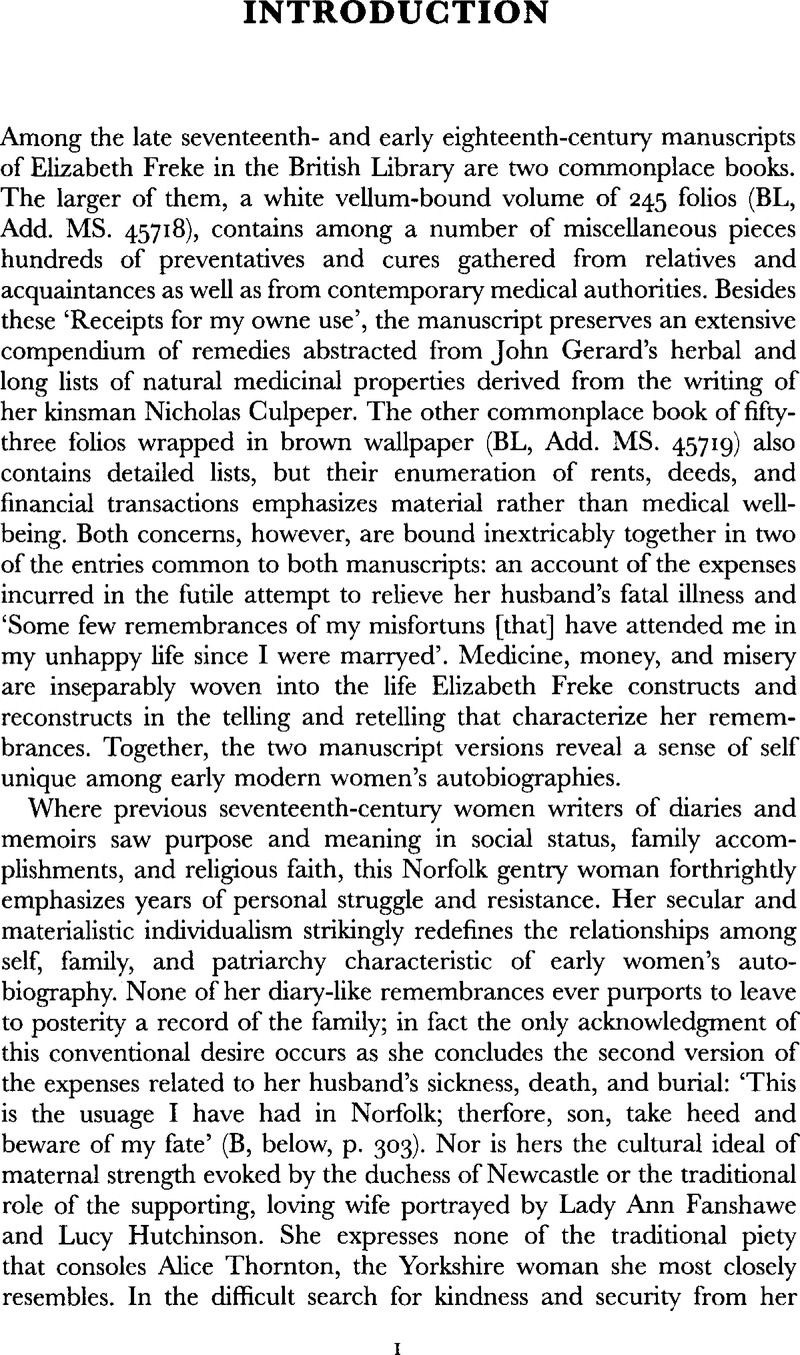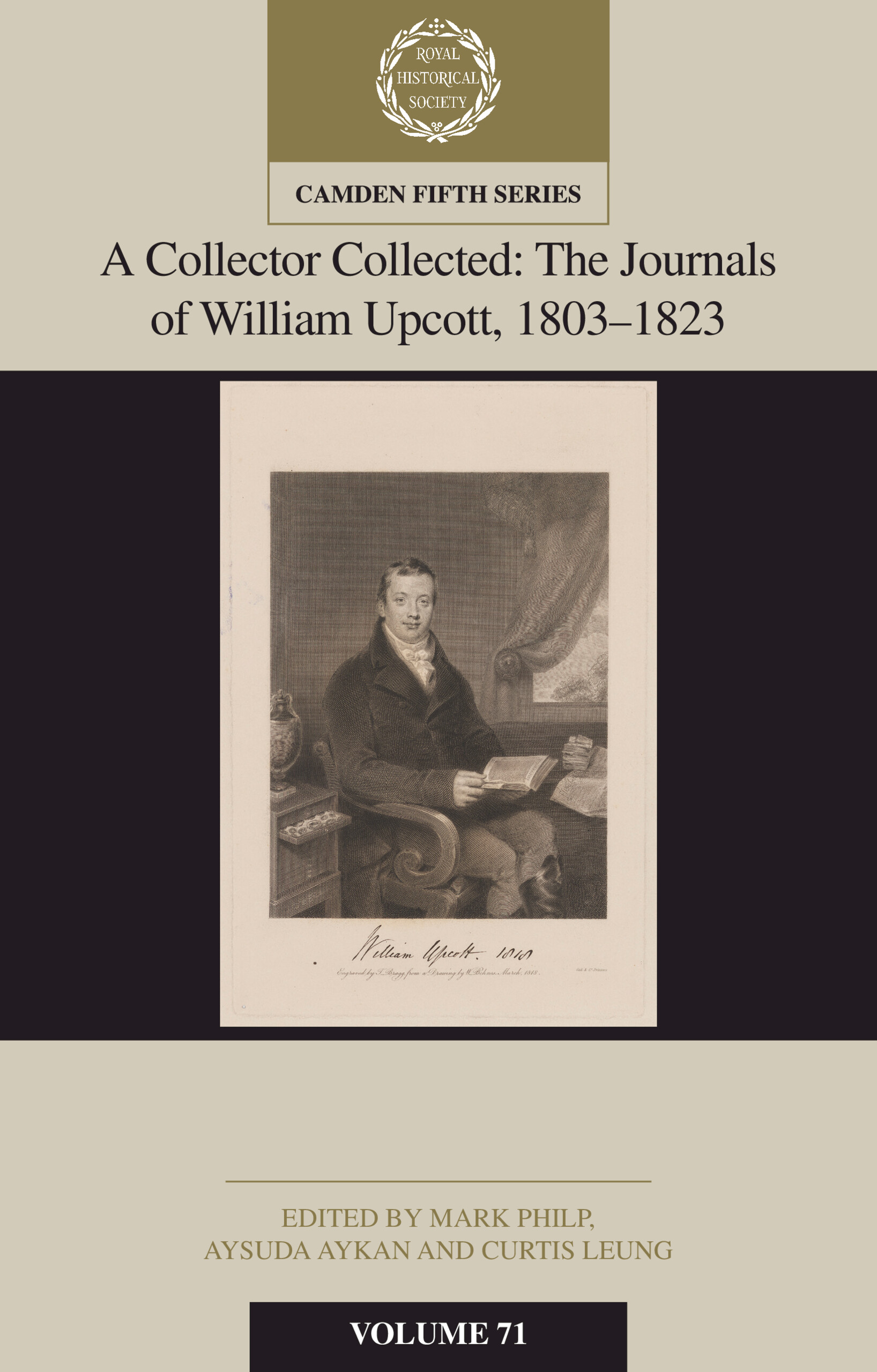No CrossRef data available.
Article contents
Introduction
Published online by Cambridge University Press: 13 October 2009
Abstract

- Type
- Introduction
- Information
- Copyright
- Copyright © Royal Historical Society 2001
References
1 Published by Guy and Co. Ltd in Cork, 1913; also in CHAS, and ser., 16–19 (1910–1913).Google Scholar
2 Carbery, , ‘Introduction’, 12.Google Scholar
3 The day of the week usually matches the date, indicating she relied on an earlier form of diary notations. Among the miscellaneous sections in the two manuscripts are several versions or drafts of material that appears in the remembrances.
4 Anselment, Raymond A., ‘“The Want of health”: An Early Eighteenth-Century Self-Portrait of Sickness’, Literature and Medicine, 15 (1996), 225–43.CrossRefGoogle Scholar
5 The Bodleian Library possesses A Pedigree or Genealogy of ye Family of the Frekes, which is ‘augmented’ by John Freke and ‘reduced to this forme by William Freke … July ye 14th 1706’ (MS. Eng. misc. c. 203). The pedigree was also published in 1825 by Middle Hill Press; a condensed version appears in ‘The Freke Pedigree’, ed. H. B., The Ancestor, 10 (07 1904), 179–211Google Scholar; 11 (October 1904), 36–53. Carbery's copy of the 1825 publication (BL, Add. MS. 45721 B) contains corrections by an unidentified author that are incorporated in the published version, which also has a somewhat different title page. In addition to her annotations, Carbery interleaves at the beginning her handwritten copy of ‘The Author's Generall Censure’ found in the manuscript of the genealogy now at the Bodleian.
6 The microfilm of the register in the Westminster City Archives; also Burke, Arthur Meredyth, ed., Memorials of St. Margaret's Church Westminster Comprising the Parish Registers, 1539–1660, and the Churchwarden’s Accounts, 1460–1603 (London, 1914), 175.Google Scholar
7 The Funeral Book states she died at the age of seventy-three (The Marriage, Baptismal, and Burial Registers of the Collegiate Church or Abbey of St. Peter, Westminster, ed. Joseph Lemuel Chester, Harleian Society, 10 [1875], 279 n. 7).Google Scholar
8 Church Notes in Kent, BL, Add. MS. 11259, fol. 8v, attributed to Edward Hasted; Cave-Browne, 23–4. The burial date is old style or 1651, when she would have been in her forty-first year, having been baptized on 10 October 1610. The family name is spelled both Culpeper and Colepeper in the Hollingbourne parish register and on the church monuments. Culpeper, the name preferred in the Freke genealogy begun by Freke's father, will be used throughout this edition.
9 SG, DO/R51, transcribed by P. J. Rives Harding.
10 Erected in memory of their parents in 1654 by Ralph and William Freke as transcribed in John Hutchins, The History and Antiquities of the County of Dorset, 3rd edn., rev. William Shipp and James Whitworth Hodson, 4 vols. (Westminster, 1861–70), iv. 99.
11 Alumni Oxonienses, … 1500–1714, ed. Foster, Joseph, 4 vols. (Oxford, 1891–1892), ii. 534Google Scholar; Middle Temple Register, i. 111Google ScholarMiddle Temple Records, ii. 654, 733, 835Google Scholar; iii. 1,079.
12 Hasted, , v. 526–7Google Scholar; a memorial in the Hollingbourne church also notes Cicely's marriage to ‘Radulpho Freke de Allington in Thornham Ar.’ (BL, Add. MS. 11259, fol. 8r).
13 Fry, Claude B., Hannington. The Records of a Wiltshire Parish (Gloucester, 1935), 35.Google Scholar
14 Hasted, , v. 466–7Google Scholar; Cave-Browne, 14–16; Harrison, Fairfax, The Proprietors of the Northern Meek Chapters of Culpeper Genealogy (Richmond, Va., 1926), 55–7Google Scholar; Prichard, M. F. Lloyd, ‘The Significant Background of the Stuart Culpepers’, Notes and Queries, n.s., 7 (1960), 411CrossRefGoogle Scholar. A 30 April 1646 entry in the Calendar of the Proceedings of the Committee for Compounding, &c., 1643–1660, ed. Green, M. A. E., 5 vols. (London, 1889–1892)Google Scholar notes that he ‘Never took up arms’; the fine of £1,318 was subsequently reduced to £844 (ii. 1,235).
15 CP, iii. 363–4Google Scholar; Cave-Browne, 25–8; Harrison, , Proprietors of the Northern Neck, 62–8Google Scholar; Attree, F. W. T. and Booker, J. H. L., ‘The Sussex Colepepers’, Sussex Archaeological Collections, 47 (1904). 67–9.Google Scholar
16 The Freke genealogy documents the birth; the Amport area registers for this period no longer exist. The Registers of Wadham College, Oxford, ed. Gardiner, Robert Barlow, 2 vols. (London, 1889–1905), i. 67Google Scholar; Middle Temple Register, i. 115.Google Scholar
17 Townshend, Dorothea, ‘Freke Pedigree’, CHAS, 2nd ser., 11 (1905), 99Google Scholar, and The Life and Letters of the Great Earl of Cork (New York, 1904), 69, 298Google Scholar; Burke's Irish Family Records, 5th edn. (London, 1976), 1,039.Google Scholar
18 On 22 October 1618 James I directed the lord deputy and chancellor ‘to regrant to the Lord Barry, Lord Viscount Buttevant, all his estates’, including Rathbarry (CSPI, 1615–25, 216Google Scholar).
19 BL, Sloane 1008 describes the hardships those within the castle suffered from 12 January to 18 October, when they were relieved by Charles Vavasour and William Jephson and removed to Bandon. The castle was then set afire to thwart the Irish rebels (Gillman, Herbert Webb, ed., ‘Siege of Rathbarry Castle, 1642’, CHAS, 2nd ser., 1 [1895], 1–20).Google Scholar
20 Fifteenth Annual Report, iii. 623Google Scholar; CSPI, 1660–2, 316, 317, 319.Google Scholar
21 Edward Hyde, first earl of Clarendon, Calendar of the Clarendon State Papers Preserved in the Bodleian Library, ed. Routledge, F. J. et al. , 5 vols. (Oxford, 1869–1970), v. 280.Google Scholar
22 CJI, i. 589Google Scholar; 6 July 1663, Middle Temple Register, i. 168.Google Scholar
23 ‘Siege of Rathbarry Castle’, 19Google Scholar; at his death in 1706, according to the remembrances, he was ‘in the sixty third yeare of his age’ (below, p. 253). Arthur Freke was among those who took the freemen's oath on 20 September 1644; he also became, according to C. M. Tenison, a lieutenant in the parliamentary army (The Council Book of the Corporation of Toughal, from 1610 to 1659, from 1666 to 1687, and from 1690 to 1800, ed. Richard Caulfield [Guildford, Surrey, 1878], 249Google Scholar; ‘Cork M.P.'s, 1559–1800’, CHAS, 2nd ser., 1 [1895], 378).Google Scholar
24 Middle Temple Records, iii. 1,253.
25 Allegations for Marriage Licences Issued by the Dean and Chapter of Westminster, 1558 to 1699, ed. Joseph Lemuel Chester and George J. Armytage, Harleian Society, 23 (1886), 165.Google Scholar
26 Philipot, John, Villare Cantianum; Or, Kent Surveyed and Illustrated (London, 1659), 72Google Scholar; Hasted, , vii. 562, 488–9.Google Scholar
27 Frances' father-in-law, George Norton, was knighted on 13 May 1660 ‘for his service in entertaining King Charles at his house & helping to convey him to Trent’; her husband was knighted on 14 December 1671 (Le Neve's Pedigrees of the Knights, ed. George W. Marshall, Harleian Society, 8 [1873], 58, 57).Google Scholar
28 Collinson, John, The History and Antiquities of the County of Somerset, 3 vols. (Bath, 1791), iii. 154.Google Scholar
29 Hasted, , vii. 206–7, ii. 174–5Google Scholar; HC, i. 573–4.Google Scholar
30 PRO, C 33/247, fol. 140r; see also fols. 34r–v, 73r, and 202r.
31 NRO, 19375 103X2. On the outside of the document, apparently in Freke's hand, is the notation, ‘Deede of Dowre to the Lady Ann Richerson wch she Injoyed 27 Years’.
32 Historical Manuscripts Commission. Calendar of the Manuscripts of the Marquess of Ormonde, K. P., ed. F. Elrington Ball, n.s., 7 (London, 1912), 397.Google Scholar
33 Cork Remembrancer, 330Google Scholar; transcribed from a Trinity College, Dublin manuscript.
34 The parliamentary journals, for example, refer to him variously as Colonel and Mr Freake.
35 Referred to the treasury on 4 June 1693 (CSPD, 1693, 169–70).Google Scholar
36 Cork Remembrancer, 317.Google Scholar
37 Fifteenth Annual Report, iii. 392, 393.Google Scholar
38 ‘Bishop Dive Downes’ Visitation of his Diocese, 1699–1702’, ed. T. A. Lunham, CHAS, and ser., 15 (1909), 84, 86, 131Google Scholar; The Manuscripts of the House of Lords, 1712–1714, ed. Maurice F. Bond, n.s., 10 (London, 1953), 273–4.Google Scholar
39 Pechey, John, A Plain and Short Treatise (London, 1698), 10Google Scholar; International Dictionary of Medicine and Biology, ed. Landau, Sidney I., 3 vols. (New York, 1986), iii. 3,096, ii. 1,378.Google Scholar
40 PRO, PROB 11/489/145.
41 NRO, DN/CON/57.
42 PRO, PROB 11/539/67.
43 Christine Reynolds, Assistant Keeper of the Muniments.
44 CB, v. 15–16.Google Scholar
45 CB, v. 378Google Scholar; CP, iii. 9–12.Google Scholar
46 Blomefield, viii. 354.
47 Mary Carbery noted some of the apparent changes during a visit in the first years of the twentieth century. Nicolaas Velzeboer, whose family owned the immediate property until he sold the uninhabited house ‘in approximately 1985’, has indicated in correspondence that the dwelling long known as the Manor House, and currently part of the Manor Farm owned by Stephen Fry, had been faced in yellow brick ‘at some stage … as the home of a wealthy person’. Reverend Stuart Robert Nairn, The Rectory, Narborough, has also kindly provided the further information about the church.
48 A Survey of the Estate of Sir John Freke Bart, in the County of Cork by Thomas Sherrard, 1787. Reverend C. L. Peters generously made available the survey, which is in his safekeeping at The Deanery, Rosscarbery.
49 Neale, J. P., Views of the Seats of Noblemen and Gentlemen, in England, Wales, Scotland and Ireland, 6 vols. (London, 1818–1823)Google Scholar, iii. n.p. See also, for example, Lewis, Samuel, A Topographical Dictionary of Ireland, 2 vols. (1837; reprinted Baltimore, 1984), ii. 488–9.Google Scholar
50 CP, iii. 12.Google Scholar
51 Somerville-Large, Peter, The Coast of West Cork (London, 1974), 24–6Google Scholar; Mary Carbery's West Cork Journal, 1898–1901, ed. Sandford, Jeremy (Dublin, 1998), 137–8, 153Google Scholar. Sandford reproduces the sale catalogue in an appendix to his edition, 155–8.
52 Fry's transcription, Hannington, 74.Google Scholar
53 Coulton mentions none of the Kent family in his autobiographical account of his early life in King's Lynn, where he was born, and at the Pentney house his father later purchased (Fourscore Years: An Autobiography [Cambridge, 1943]).Google Scholar
54 1881 Census Index, PRO, RG 11/1995.
55 The Poll for Knights of the Shire for the County of Norfolk, … July 20, 1802 (Norwich, 1802), 66Google Scholar. Edmund Kent, listed in the 1806 poll, appears as a freeholder in the 1817 Norfolk Poll and Proceedings Relative to the Election (Norwich, 1817), 91Google Scholar. ‘Edmund Kent, sen., Esq.’ is lord of the manor in White, William, History, Gazetteer and Directory of Norfolk (Sheffield, 1836), 461.Google Scholar
56 Rye, ii. 1,073; Carthew, iii. 95. Edmund Kent was buried in East Winch on 30 June 1839 at the age of eighty-three. The 1864 edition of White's Norfolk directory lists his son as lord of the manors of East Winch and Carrow. The Poll for the Election of Two Knights of the Shire … Taken July 22nd, 1865 (East Dereham, 1865), 139Google Scholar, also associates Edmund Kent of Fakenham with East Winch; the 1835, 1837, and 1852 polls note that Edmund and George Kent are eligible to vote from East Winch. Edmund Kent was buried in East Winch on 25 August 1876, three years before his wife Elizabeth, who was interred on 17 November 1879. The 1885–6 Register of Persons Entitled to Vote (Wisbech, n.d.) notes that Edmund, their son, has a ‘Share of freehold house and land’ (fol. N7); he is identified in White's 1883 Norfolk directory as lord of the manors of East Winch and Carrow.
57 Reverend George Edward Kent is lord of the manor in the 1845 and 1854 editions of White's Norfolk directory. Educated at Corpus Christi and ordained in 1820, George Kent would become affiliated in 1848 with All Saints, St John's Wood, London (Venn, J. A., Alumni Cantabrigienses. Part II: From 1752 to 1900, 6 vols. [Cambridge, 1940–1954], iv. 25).Google Scholar


